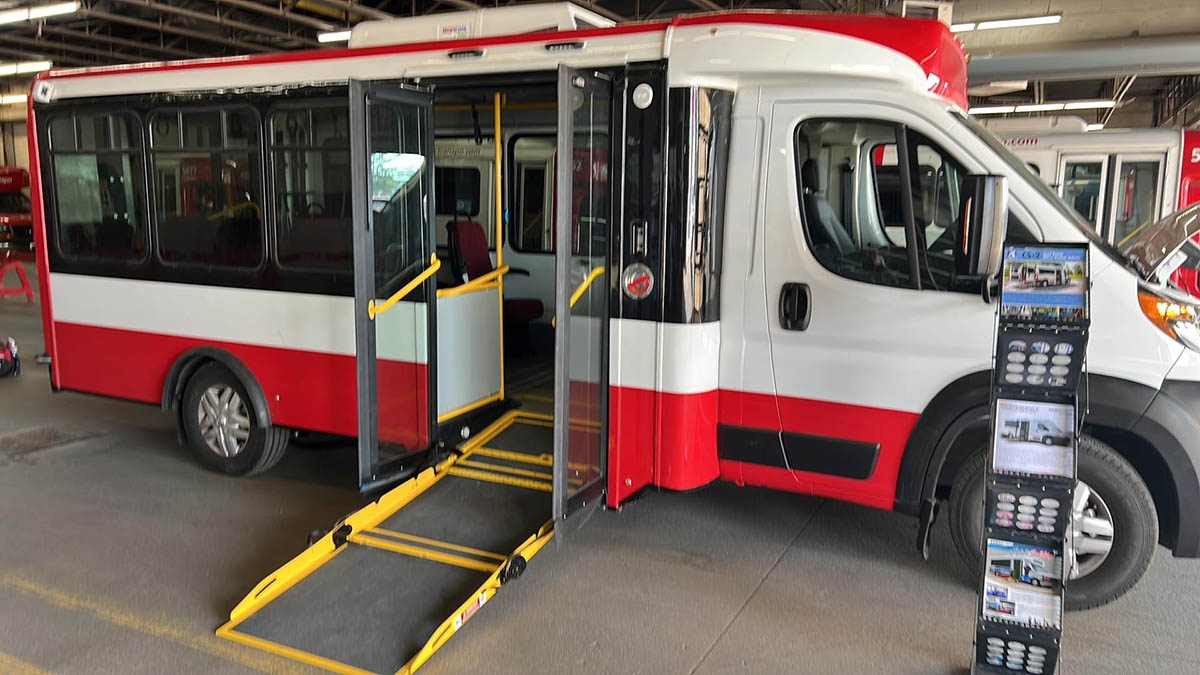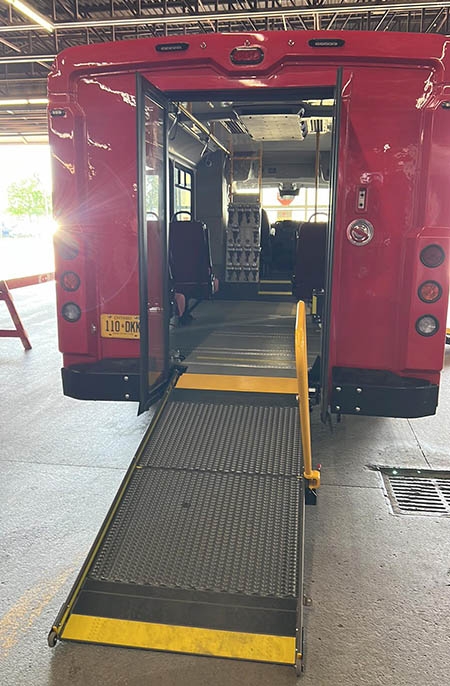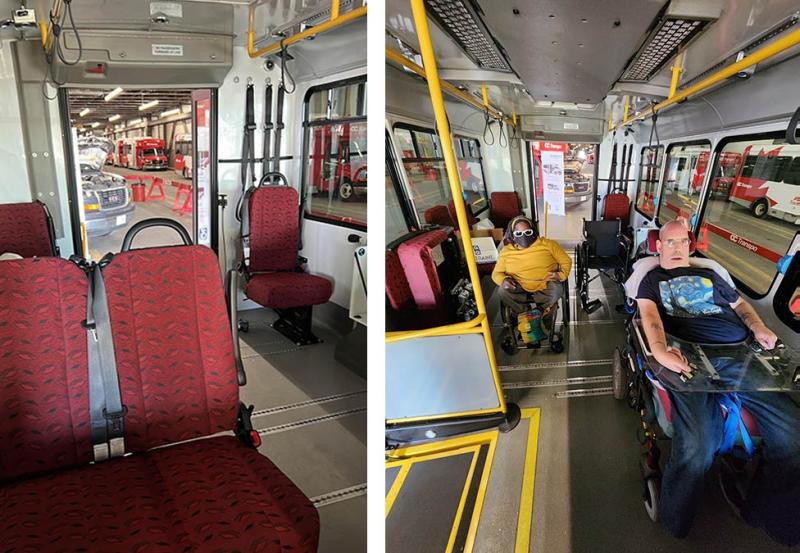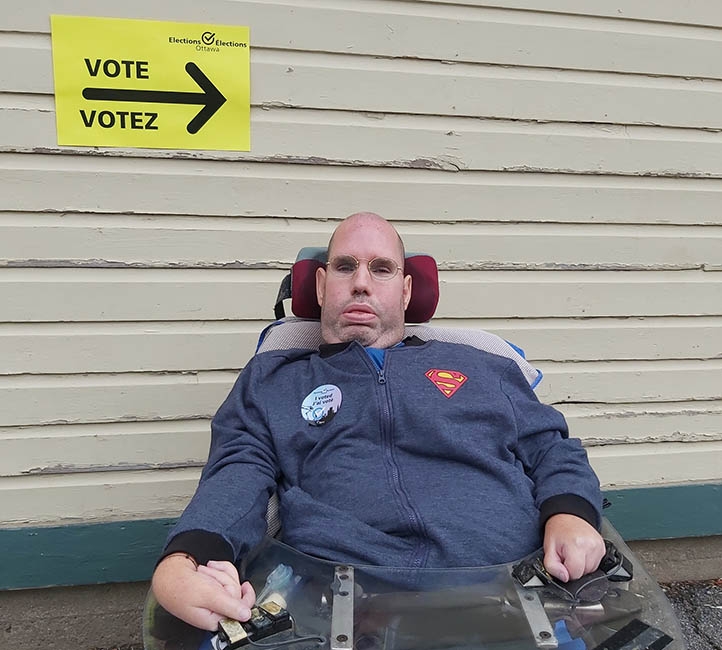
A Look at Potential New Para Transpo Buses
Last week, Sally Thomas and I had the opportunity to check out two proposed new Para Transpo buses.
Sally Thomas has also been a long-time Para Transpo user and a strong advocate for wheelchair accessibility. On a personal note, Sally and I have been friends for almost thirty years, and we’ve fought side-by-side on several issues regarding better Para Transpo service and more.
Before I get into my observations about the proposed new buses, I want to say something important.
When it comes to people with disabilities, our disabilities affect us in many ways. A basic example would be that some may require a mobility device to get around while others may not. Mobility devices can also range in size and complexity.
That said, I should point out that Sally’s manual wheelchair is much smaller than mine. My wheelchair is much bigger and is a powered chair. So, when we checked out the new Para Transpo vehicles, we had different needs and concerns that we were able to share with OC Transpo officials in person.
Upon our arrival at the OC Transpo garage, we were greeted by several OC Transpo staff and introduced to two proposed new Para Transpo buses. Both buses were from the TTC in Toronto. On site were a larger vehicle and a smaller vehicle.
At first glance, both appeared to be very similar to current Para Transpo vehicles. Both were low-floor vehicles with two fold-out ramps. One in the front and one in the back. Inside both vehicles were spaces for up to four or five wheelchairs and seats, some of which could be folded down.
Let’s start with the ramps.
Ever since Para Transpo started using low-floor buses, and fold-out ramps, I’ve had several incidents where my wheelchair tipped backwards due to how steep the ramps are. Fortunately, I haven’t tipped all the way over but I have been close. For that reason, I’m more partial to the old-school ramps. The ones that were completely flat and went up and down. I understand the need for low-floor buses and ramps, though.

The idea behind low-floor buses is that they make it easier for people in wheelchairs and using other mobility devices to board and disembark from a bus easily. For some PWD, the driver can push a button, and the bus and ramp will lower to the curb. The passenger can then roll onto the bus and into a spot for a wheelchair. In my experience, other PWD in large and sometimes small wheelchairs also have the same issues I do and require assistance due to the steepness of the ramps.
Speaking of requiring assistance, I’ve had and seen several Para Transpo and OC Transpo drivers refuse to help PWD and seniors with boarding the bus. If OC Transpo continues to use low-floor buses and ramps, all drivers should be required to help PWD and seniors get on and off the bus. The same goes for wheelchair-accessible taxis.
As far as the ramps on the potential new buses, I found them to be steeper. Remember that we were inside a garage at the time instead of a sidewalk. The ramps wouldn’t be so steep if we were on a sidewalk.
Let’s now talk about the inside.
As I said earlier, two different types of buses were on display. A bigger one and a smaller one. I found both to be a little cramped and tight. For example, I sat in the back when I took a test ride in the smaller bus. There were two regular seats on both sides of me. One of the OC Transpo officials sat to my right. During the test ride, I almost got elbowed by them. Nothing happened, but I could easily see how it could happen, especially if the passenger can’t fully control their body.
The other thing I noticed was the lack of space for the driver to strap down our mobility device. While some seats can be folded down to allow for more space, the more seats that need to be folded down means more added time to our trips.

ABOVE: Sally Thomas and Ryan Lythall try out the proposed new Para Transpo buses.
Besides the fact that the ride was smoother, I didn’t notice any difference between the proposed new buses and the current ones. I think very little consideration was given to passengers with bigger wheelchairs and other large mobility devices. There must be more space for the passenger and the driver to secure our device and for the caregiver to move around the vehicle, especially in an emergency.
My answer is no. The proposed buses need to be bigger to accommodate all passengers.
We need space.
My ideal solution is to have more space on the right side of the bus. That way, passengers using wheelchairs would be on the right instead of staring directly at the back of the driver’s seat. The driver could also focus on securing mobile devices on one side of the vehicle, Instead of one or two passengers on the left side, one or two in the back, and one or two on the right. Less zigzagging means less time for everyone.
Again, finding a perfect solution is almost impossible. Every person with a disability has different needs and/or requires various devices. I do appreciate that OC Transpo and the City of Ottawa are asking for feedback and trying to improve their service.
Before writing this article, I asked Sally if she wanted me to mention anything on her behalf. Her request was simple and the same as mine,
Thank you to all the people at OC Transpo who invited us to participate in the process. We truly appreciate the opportunity to be heard and have our opinions considered.









